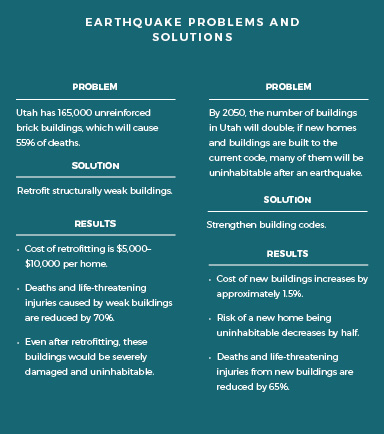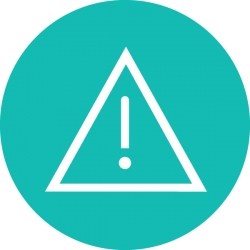Background:
Utah has a one-in-four chance of experiencing a major earthquake in the coming decades. Across the state, the risk of fire, flooding, and other disasters is also significant and may be increasing. When major natural disasters have occurred, many places in the world and in the U.S. have taken years, even decades, to recover—if they recover at all. A place that is resilient to disasters is able to survive, adapt, and eventually thrive, no matter the catastrophe it experiences. It can quickly recover from disastrous events without disrupting long-term economic health and residents’ quality of life.
Utah has an unusually high risk of a major disaster disrupting the state’s economy and impacting the lives of millions. Almost more than anywhere else in the U.S., many Utahns have focused on preparation to survive in the hours and days immediately following a disaster. Making Utah disaster resilient, however, requires much more. It involves improving our homes, buildings, and infrastructure to reduce the impact of a disaster, so fewer people are killed or injured, more homes and buildings survive, infrastructure and utilities can be quickly restored, and the economy is not so disrupted as to permanently damage Utah’s future.
Utahns want to substantially improve the state’s disaster resilience so they can feel safe, have less stress, and reduce the likelihood that they or their children will have to move away from Utah if a disaster occurs and the economy suffers. They also want to be able to quickly recover and return to their normal lives. Disaster resilience in Utah is a growing concern for individuals, communities, and the state as a whole. Eighty percent of Utah’s population lives in areas that are at high risk for a major earthquake; 13% of homes (128,800) are at high or extreme risk from wildfires; and the severity of storms around the country is increasing, suggesting higher risks of flooding in Utah.
What is disaster resilience?
Disaster resilience is the ability to survive, adapt, and eventually thrive after a disaster of any type or severity. Disaster-resilient communities can withstand and quickly recover from catastrophic events without experiencing long-term disruptions to the economy or way of life. Disaster resilience requires looking beyond short-term preparedness (having 72-hour kits, two-week water supply, etc.); Utah needs to implement long-term strategies to lessen the impact of disasters on Utahns’ lives and homes and the state’s businesses, infrastructure, and economy. The historical reality is that some places never truly recover from natural disasters. After catastrophes occur, urban areas can experience such devastating damage that the costs of repairs are prohibitive or take many years.
By the time infrastructure and buildings are rebuilt, jobs, businesses, and residents may already be gone for good. However, actions taken now to improve disaster resilience will ensure that future generations are better able to withstand a disaster in Utah.
What are the top risks to the state?
Earthquakes
A large portion of Utah’s population lives near fault lines and on liquefaction areas, where soil can become like quicksand in an earthquake. A powerful 7.0 earthquake is estimated to occur roughly once every 300 years along the Wasatch Fault, and the last earthquake of that size occurred about 350 years ago on the Nephi segment of the fault. Such an earthquake in 2050 could cause significant damage (especially to older buildings), displace people from over 100,000 households, and cause over 14,000 deaths and life-threatening injuries.
Of particular concern is the number of high-risk unreinforced masonry buildings (URMs) in the state. A URM is a building in which the main supporting walls are made of material like brick, stone, or concrete and lack adequate steel or wood structural support to withstand the shaking of a large earthquake. In Utah, most URMs were built between the 1860s and the mid-1970s. About 165,000 URMs are currently at risk of being damaged or destroyed by an earthquake along the Wasatch Front. By comparison, California, another state with high earthquake risk, has only 26,000 URMs that have not been reinforced. (California prohibited the construction of URMs in the 1930s and began requiring the reinforcement of URMs in the 1980s.)
Disruption of utilities could leave people without power, water, and gas. Disruption of businesses could leave many Utahns without jobs and permanently damage the economy. The more Utahns do now to minimize damage from a large earthquake, the faster they will be able to recover.

Flooding
Flooding is a significant risk to many places in the state, and floods are becoming more common as storms become more severe. Recently, multiple neighboring states have experienced large-scale flooding from bigger-than-anticipated storms. Despite this, only 4,500 properties in Utah have federal flood insurance, even though 99% of Utah residents live in communities that are eligible for it. Utah’s storm-water systems are designed for storms smaller than what the state is likely to experience in the future, which puts urban areas at a higher risk of floods than in the past. In addition, many of Utah’s watersheds are not as healthy as they could be, which also could result in increased flooding, particularly after wildfires.
Wildfires
Wildfires have always occurred in Utah, but Utahns are now building more homes on the fringe of urban areas, closer to where wildfires usually occur. It is estimated that there are about 800–1,000 wildfires on average every summer in Utah, with 30% of these fires caused by humans. Thirteen percent of homes (128,800) in the state are at high or extreme risk of wildfires, with the number continuing to grow every year. Homes and communities can better withstand wildfires by reducing how scattered growth is, creating defensible spaces to buffer homes from fuel sources (e.g., brush and small trees), and building with fire-resistant materials.


